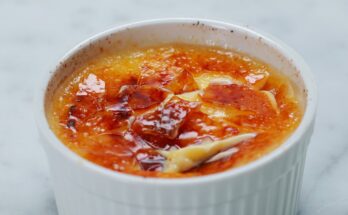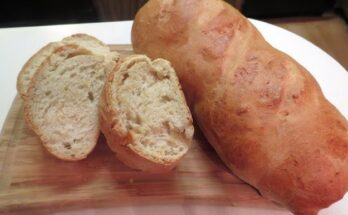Quiche Crust Recipe: A buttery, flaky quiche crust is the unsung hero of every great quiche. Sure, the filling steals the show, but without a well-made crust, even the most flavorful custard can fall flat. Whether you’re baking a classic quiche Lorraine or going wild with spinach and goat cheese, the crust is your foundation. And while store-bought crusts may offer convenience, they rarely deliver on taste or texture. Once you master this step-by-step guide, you’ll never settle for anything less than homemade again. Ready to roll?
Ingredients You’ll Need
Let’s talk ingredients. Making a perfect quiche crust starts with keeping it simple. You don’t need fancy or exotic items—just quality, fresh basics. Here’s what you’ll need:
- All-purpose flour (1¼ cups): This is the backbone. Unbleached is ideal.
- Unsalted butter (½ cup, cold): The colder, the better. It gives you that signature flaky texture.
- Salt (½ tsp): A small amount that enhances flavor.
- Ice water (3–4 tbsp): This helps bind the dough without warming it.
Want to jazz things up? Consider adding a pinch of sugar for sweetness or some grated Parmesan cheese or dried herbs for a savory twist. These optional additions can transform a simple crust into something truly memorable.
Tools and Equipment
Making a quiche crust is less about fancy gadgets and more about technique, but a few key tools will make your life easier:
- Mixing bowl
- Pastry cutter or two knives (or a food processor)
- Rolling pin
- Plastic wrap or parchment paper
- 9-inch pie pan or tart pan
- Baking weights or dried beans for blind baking
- Fork or docking tool for piercing the crust
These items help ensure your crust is evenly mixed, properly shaped, and perfectly baked—no soggy bottoms here!
Step-by-Step Guide to Making Quiche Crust
Let’s break down the process. This guide ensures you get a consistent, buttery, and flaky crust every single time.
Step 1: Gather Your Ingredients
It may sound obvious, but prepping all your ingredients ahead of time is key. Measure everything precisely—baking is a science, not a freestyle jam session. Dice the butter and return it to the fridge so it stays cold. Have your ice water ready, too. Small steps like these make a big difference later on.
Step 2: Mix Dry Ingredients
In a large bowl, combine the flour and salt. Whisk or sift to distribute evenly. This ensures your dough will be seasoned throughout and have a uniform structure. If you’re adding any herbs or cheese, toss them in here.
Step 3: Cut in the Butter
Now comes the magic step: incorporating the butter. Use a pastry cutter, fork, or your fingers to work the butter into the flour until the mixture resembles coarse crumbs. Some pea-sized chunks are okay—they melt during baking, creating pockets of flakiness.
Want to use a food processor? Pulse it a few times—don’t overmix. Too much blending will warm the butter and develop gluten, resulting in a tough crust. Remember, this isn’t bread; we’re aiming for tender.
Step 4: Add Cold Water
Gradually add ice water, one tablespoon at a time. Stir gently with a fork or your hands after each addition. You want the dough just moist enough to hold together when pinched—no wetter. Overhydrating leads to a gummy crust, and we want flaky!
As soon as the dough clumps together, stop. You’re not kneading it like bread; the less you handle it, the better. Shape it into a flat disc, wrap it tightly in plastic wrap, and refrigerate it for at least 30 minutes. This resting period allows the gluten to relax and the butter to firm up again.
Step 5: Form the Dough and Chill
Once chilled, remove the dough from the fridge. Lightly flour your surface and rolling pin, then roll it out to about 12 inches in diameter. Start from the center and work your way out, turning the dough occasionally to keep it round.
Carefully transfer the dough to your pie or tart pan. Gently press it into the bottom and up the sides without stretching. Trim any overhang and crimp the edges if desired. Prick the bottom all over with a fork (this prevents bubbling). Chill it again for 15-20 minutes before baking. This extra chill helps hold the crust’s shape in the oven.
Rolling Out and Fitting the Crust
Rolling out the quiche crust is where finesse comes into play. You’ve already prepped and chilled your dough—great! Now comes the part that makes many home bakers nervous: turning that cold, solid disc into a smooth, even circle without tearing or sticking. But don’t worry—we’ve got your back.
Start by placing the dough on a lightly floured surface. Lightly flour the top of the dough and your rolling pin, too. Begin rolling from the center outward, rotating the dough a quarter turn after every few rolls. This helps maintain a circular shape and prevents sticking. The goal is to roll it into a 12-inch circle, about 1/8-inch thick.
Now, the transfer. A simple way to move the dough without disaster? Gently roll it around your rolling pin, lift it, and unroll it over the pie or tart pan. Then, using your fingertips, gently press the dough into the corners and up the sides of the pan. Avoid stretching it—this can cause the crust to shrink as it bakes.
If you’ve got excess dough hanging over the edge, trim it with a sharp knife or kitchen scissors. To get fancy, crimp the edges with your fingers or a fork. Don’t skip pricking the bottom with a fork (also known as docking). It lets steam escape and helps the crust bake evenly.
Finally, pop that lined pan back in the fridge for 15-20 minutes. Why? Because a cold crust holds its shape better in the oven, reducing shrinkage and slumping.
Blind Baking the Crust
Blind baking is the secret weapon of quiche crust mastery. It ensures your crust is fully cooked and crisp before the custard filling is added. Without it, you risk that dreaded soggy bottom. And no one wants a mushy slice of quiche.
First, preheat your oven to 375°F (190°C). Take the chilled crust and line it with parchment paper or aluminum foil. Then, fill it with pie weights, dried beans, or even uncooked rice. This weight holds down the dough and prevents bubbling and puffing during baking.
Bake for about 15-20 minutes or until the edges are lightly golden. Then, remove the weights and parchment and bake for another 5-10 minutes to dry out the bottom. The goal? A lightly golden, crisp crust that’s ready to hold your delicious filling.
If your quiche recipe calls for a very wet or egg-heavy filling, blind baking becomes even more important. It gives your crust a head start and prevents it from becoming saturated. A pro tip: if you notice the bottom puffing up after removing the weights, gently press it back down with a spoon or fork while it’s still warm.
Common Mistakes to Avoid
Even experienced bakers stumble with crusts now and then. Let’s go over the most common mistakes and how to avoid them:
- Overworking the Dough: Mixing or kneading too much develops gluten, which makes your crust tough instead of tender. As soon as the dough comes together, stop.
- Using Warm Butter: Cold butter is crucial. Warm butter melts into the flour, ruining those flaky layers. Always keep your butter and water as cold as possible.
- Skipping the Chill Time: Chilling isn’t optional—it’s a must. It relaxes the gluten, solidifies the fat, and prevents shrinkage. Rushing this step will cost you in texture and shape.
- Stretching the Dough: When fitting the dough into the pan, never stretch it to cover gaps. Dough that’s stretched tends to pull back during baking, creating holes or slumps.
- Skipping Blind Baking: If your recipe needs a pre-baked crust, don’t cut corners. Blind baking gives your crust structure and avoids a soggy, undercooked bottom.
Avoiding these pitfalls helps you achieve that golden, crisp, buttery crust that’s the hallmark of a great quiche. And trust us, once you get it right, there’s no going back.
Tips for a Perfect Quiche Crust
Now that we’ve dodged the pitfalls, let’s lock in a few expert tips to elevate your crust to bakery-level:
- Use a mixture of butter and shortening if you want the perfect combo of flavor and flakiness. Butter gives taste, shortening offers structure.
- Add flavor boosters like fresh herbs (thyme, rosemary), spices (paprika, nutmeg), or cheeses (Parmesan, cheddar) into the dough.
- Don’t skip the resting stage after rolling and before baking. It sets the shape and prevents the crust from sliding down the sides.
- Use a glass or ceramic pie dish if possible. It helps you see when the crust is golden on the bottom.
- Brush the bottom of the crust with egg white before blind baking to seal it and create a barrier against soggy fillings.
With these tips in your toolkit, your quiche crust won’t just be good—it’ll be irresistible.
Gluten-Free and Alternative Crust Options
Going gluten-free or just want to switch things up? No problem. You can still enjoy a killer quiche with a crust that fits your dietary needs or taste preferences. While traditional quiche crusts use all-purpose wheat flour, there are several great alternatives that work just as well with a few technique tweaks.
1. Almond Flour Crust
Almond flour is a popular gluten-free substitute. It’s naturally nutty, low in carbs, and high in protein and healthy fats. To make an almond flour crust, mix almond flour with a bit of melted butter or coconut oil and a pinch of salt. It’s more of a press-in dough, so no rolling is needed. Just press it into the pan and bake it for 10–12 minutes before filling.
2. Oat Flour Crust
Oat flour offers a slightly sweet, hearty flavor. You can make it yourself by blending rolled oats until fine. Combine with butter or oil and a binding agent like an egg or flaxseed meal. This one also works best as a press-in crust.
3. Cauliflower Crust
Yep, cauliflower isn’t just for pizza. Finely grated and well-drained cauliflower mixed with cheese and eggs makes a low-carb, gluten-free quiche crust that holds up surprisingly well. It’s definitely non-traditional, but it works beautifully for a healthier twist.
4. Store-Bought Gluten-Free Crusts
Short on time? There are many store-bought gluten-free options now. Just make sure to check the ingredients list for any additives or allergens, and always pre-bake according to package instructions before adding your filling.
Alternative crusts may not have the same buttery flakiness as classic pastry, but they bring their own charm to the table. Whether you’re following a special diet or just experimenting, these options keep your quiche game strong.
Storing and Freezing the Dough
One of the great things about quiche crust dough is how well it stores. You can make it ahead and keep it on hand for whenever the craving strikes.
Refrigerator Storage: After forming the dough into a disc, wrap it tightly in plastic wrap. It will keep in the fridge for up to 3 days. When ready to use, let it sit at room temperature for 10–15 minutes before rolling out—it’ll be easier to work with.
Freezing the Dough: For longer storage, freeze the wrapped dough disc in a freezer bag. It’ll stay fresh for up to 2 months. To use, thaw it in the fridge overnight, then roll and bake as usual.
Freezing Pre-Rolled Crusts: You can also roll out the dough, fit it into the pie dish, and freeze it that way. Wrap the whole pan tightly in plastic wrap and foil. When you’re ready, bake straight from the freezer—just add a few minutes to the bake time.
This make-ahead flexibility means you can always have a crust ready to go, whether you’re prepping for brunch or making a last-minute dinner.
Pairing Your Quiche Crust with Fillings
A great quiche crust deserves a great filling. While you can get creative, some combos work better than others, especially when it comes to flavor balance and moisture content.
Classic Combos:
- Quiche Lorraine: Bacon, Gruyère cheese, and caramelized onions
- Spinach & Feta: Earthy greens and tangy cheese
- Ham & Swiss: Savory and creamy, perfect for brunch
- Mushroom & Goat Cheese: Rich, umami-packed, and slightly tangy
Breakfast Fillings:
- Eggs, sausage, cheddar, and hash browns
- Smoked salmon, dill, and cream cheese
Dinner Fillings:
- Roasted vegetables, ricotta, and herbs
- Chicken, sun-dried tomatoes, and mozzarella
Pro Tips:
- Avoid watery vegetables like zucchini unless pre-cooked.
- Balance flavors—too much salty or sweet can overpower.
- Don’t overfill the crust. Leave about ¼ inch at the top for expansion.
A well-matched filling enhances the crust’s flavor and texture, making each bite a satisfying mix of buttery, savory, and creamy goodness.
Nutritional Information
Here’s a quick breakdown of the nutritional info for a standard 9-inch quiche crust (using traditional ingredients):
| Nutrient | Amount per Serving (1/8 crust) |
|---|---|
| Calories | 160-200 |
| Total Fat | 12-15g |
| Saturated Fat | 7-9g |
| Carbohydrates | 12-15g |
| Protein | 2-3g |
| Sodium | 100-150mg |
Note: These numbers can vary depending on the ingredients used (e.g., butter vs. shortening, added cheese or herbs). Gluten-free and low-carb options will have different profiles, usually lower in carbs but higher in fat depending on the flour base.
Being mindful of nutrition is important, especially if you’re serving quiche regularly. Consider your dietary needs and tweak your recipe as needed.
FAQs about Quiche Crust Recipe
1. Can I make quiche crust without butter?
Yes! You can use shortening, lard, or even coconut oil for a dairy-free crust. Just keep the fat cold and follow the same method.
3. Should I bake the crust before filling it?
Chill the dough before baking, avoid stretching it when placing in the pan, and blind bake with pie weights.
3. Should I bake the crust before filling it?
Yes, blind baking helps prevent a soggy crust, especially if you’re using a wet or custardy filling.
4. Can I use store-bought dough?
You can, but homemade tastes much better and allows for customization. Still, store-bought works in a pinch—just pre-bake it.
5. What’s the difference between pie crust and quiche crust?
Not much! Both are typically shortcrust pastry, but quiche crust might be slightly sturdier to hold up to the moist filling.
Final Thoughts
Making a quiche crust from scratch might sound intimidating, but it’s totally doable—and worth it. With just a handful of ingredients and a bit of technique, you can turn out a crust that’s miles better than anything store-bought. It’s flaky, buttery, and perfectly tender—just the base your savory filling deserves.
Whether you’re baking for a weekend brunch, a family dinner, or meal prepping for the week, a homemade crust makes all the difference. Plus, once you’ve got the hang of it, it’s super flexible. From traditional wheat to gluten-free, from basic to bold, the options are endless.
So the next time you’re tempted to grab a frozen pie shell—pause. You’ve got the skills now. Make it from scratch. You—and your taste buds—won’t regret it.



